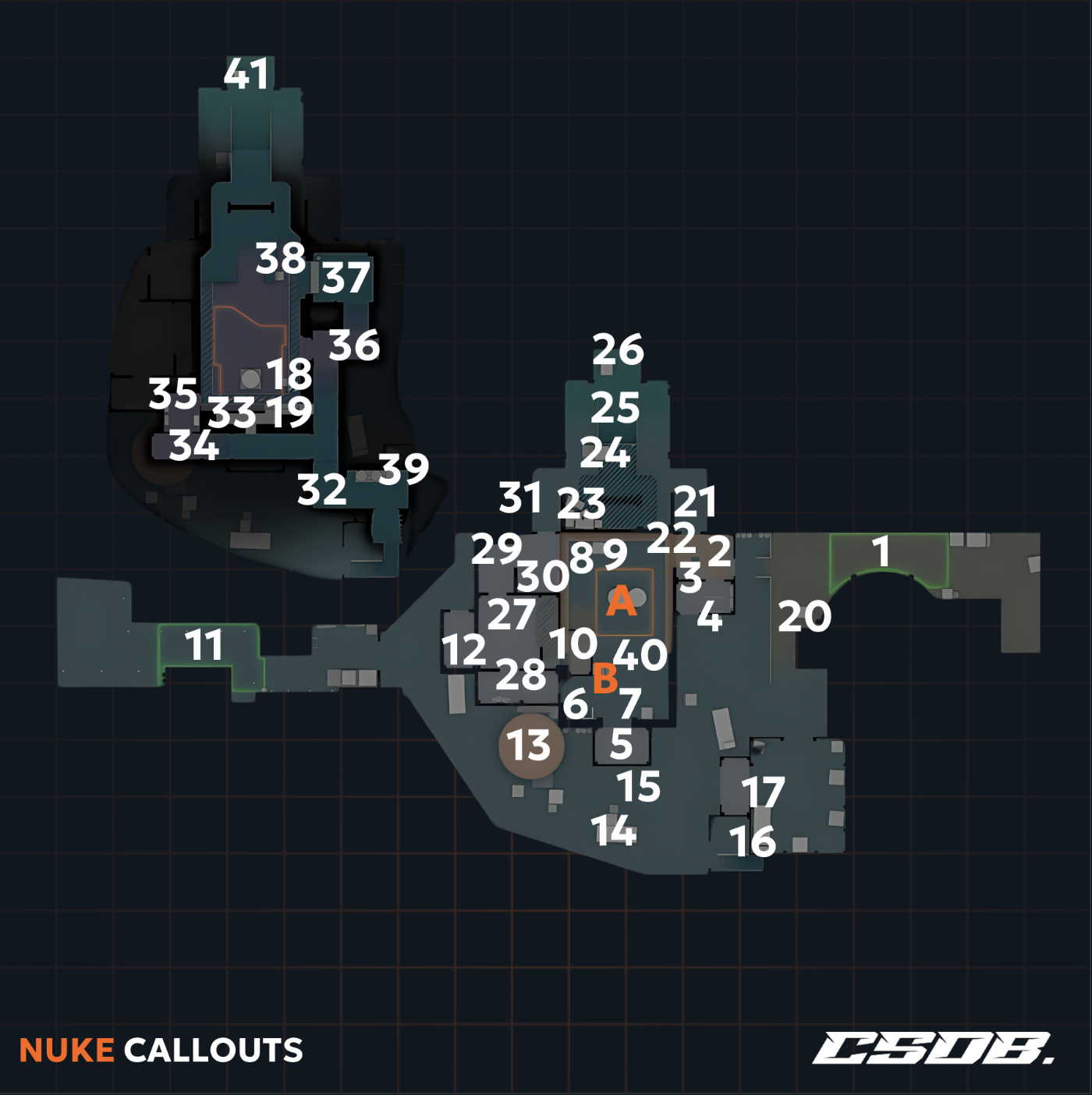Nuke Callouts




-
1CT-Spawn: The starting point for defenders, essential in defensive tactics.
-
2Hell: The lower section beneath Nine, a passage for defenders into the Nuclear Block.
-
3Heaven: This is the elevated area above A platform, which can provide a tactical advantage for defenders.
-
4Lockers: The Passage connecting the main entrance to the Nine stairs.
-
5Main: Immediate pathway to the A platform from the street.
-
6Vent: The shaft that connects A platform to the lower map level, helping players with more strategic movement.
-
7Tetris: The cluster of small boxes on A platform, which allows for more agile maneuvers.
-
8Mustang: The most prominent spot on the top level of the A platform.
-
9Rafters: This is the gradual slope on the upper tier of the A platform, offering strategic elevation.
-
10Hut: A compact room for launching offensive maneuvers to secure A platform.
-
11T-Spawn: The starting point for attackers, which lays the groundwork for their offensive maneuvers
-
12T Roof: Accessible rooftop that can be accessed from both T-Spawn and the lobby, providing strategic advantages such as cliff jumping or pistol round control.
-
13Silo: The tall pipe adjacent to the roof, named for its resemblance to a sheer cliff in CS 1.6.
-
14T Red: Broad term indicating a position associated with a red box on the street.
-
15Outside: Collective term for the vicinity near Nuke’s central atomic block.
-
16Secret: The stairwell that leads to the lower atomic block tier, specifically the B site.
-
17Garage: This refers to the spacious garage located near the secret entrance.
-
18Blue: The general term related to the blue box on the street.
-
19Small Box: This is the compact shelter near the main entrance by the blue box.
-
20CT Box: The concealed container near the CT Box is often used by defensive side snipers for street control.
-
21Turn Pike: The pathway from the main entrance to the ramp that is essential for strategic movement.
-
22Stack: Crates at the ramp’s outer corner, providing cover and strategic advantages.
-
23Boost: A tactical position near the tunnel exit, offering player elevation for even better positioning.
-
24Big Box: Large box before the B plat ramp descent, which offers cover and strategic options.
-
25Ramp: An important route to descend to the B plinth, which is vital for offensive movement.
-
26HS Headshot: A strategic box at the rear of the ramp, which is important for sniper-style gameplay.
-
27Lobby: The spacious area that gives players access to the A plinth or ramp positions.
-
28Squeaky: The compact section near the lobby which is often used for strategic positioning.
-
29Radio: The first room that links the lobby to the ramp, which is vital for movement and communication.
-
30Trophy: Just after the radio corner, known for glass-encased trophies.
-
31Control: The final room before the ramp, a critical transition point for strategic movement and control.
-
32Tunnels: These are the narrow corridors after you enter Secret, essential for strategic maneuvering.
-
33Vents: This is a ventilation shaft that links the ascent to A Plant and the tunnels, helping with tactical movement.
-
34Back Vents: The leftmost passage along the ventilation shaft leading to decon.
-
35Decon: A room post-back vents descent that houses a door opening to B Plant.
-
36Doors: Another entrance to the B Plant, which is accessible from the tunnel side.
-
37Window: A glass room above the double doors.
-
38Dark: This is the concealed spot behind a crate in the far B Plant corner.
-
39Toxic: This is the designated C4 installation area, which is located in the upper left B Plat corner near the ramp exit.
-
40B Default Plant: The standard C4 plant site that is located on the far B Plant side behind the reactor.
-
41Bottom Ramp (Bottom ramp or fork): The two B Plant exits on the ramp side.
Here are the Nuke callouts for the key locations in the central area around A Plant, which have been influenced by the map’s intricacy and Counter-Strike history.
The map’s main appeal lies in its ever-evolving nature, allowing quick rotations and strategic maneuvers. Its distinctive structure has an almost maze-like environment, making it a challenging yet satisfying experience for teams to master.
This multi-level battleground requires you to navigate not just physically but also strategically as you contend with varying heights and confined spaces. Nuke’s gameplay emphasizes the vertical, which means that team coordination is absolutely vital for successful site captures and defences.
As we go through all the essential Nuke callouts, we’ll look at all the most important locations and the strategic communications you’ll need to win on this beautiful and intricately crafted map.
Mastering the Map Through Nuke Callouts
The Nuke map, which is modelled after a nuclear power plant, is one of the most iconic locations in the CS:GO universe. Callouts on the Nuke CS:GO map can be grouped into four main sections, with each one vital for important team strategies:
- CT-Spawn and A Plant
- T-Spawn and Outside
- Lobby and Ramp
- B Cross and B Plant.
Mastering the Nuke Map Callouts For the Best Play Possible
Hopefully, in this Nuke Callouts guide, we’ve taken you through all the most important zones of the Nuke map, uncovering all the essential positions and callouts you need for the most successful gameplay.
If you want to play Nuke map, then understanding T-Spawn, CT-Spawn, Lobby, Ramp, B Cross and B Plant is absolutely essential for strategic coordination, especially if you are in the terrorist team, as this is considered a CT-sided map. Each area offers its own unique tactical advantages, which underlines the necessity of familiarity with the various Nuke callouts if you want to become a CS:GO master.
Whether you’re attacking the A plat or trying to navigate through the B Plant, by memorizing these callouts, you can become an even better player. So, explore, learn, and conquer Nuke with confidence by mastering its most important callouts.
Nuke Callouts Guide FAQs
What are callouts in CS:GO?
Callouts are specific names or labels assigned to various locations on a map. They are used by players to communicate effectively with their teammates during gameplay, enabling strategic coordination and tactical maneuvers.
Why are callouts important in Nuke?
Callouts play a crucial role in Nuke as they help with proper communication and coordination among teammates. Given the complexity of the map and the need for precise positioning, knowing and using callouts ensures that you can effectively convey information about enemy positions, strategic movements, and site control to your teammates.
How can I learn Nuke callouts?
Learning Nuke callouts requires practice and familiarity with the map. You can study callout maps, watch gameplay videos, or take part in matches to become better acquainted with the names and locations of key areas on the map. Additionally, actively using callouts during gameplay helps you memorize them and helps in mastering them over time.
Are Nuke callouts the same in CS:GO and CS2?
Generally, Nuke callouts remain consistent across different versions of the game, including CS:GO and CS2. While there may be slight variations or additions in newer iterations, the core callouts and their locations remain largely the same, so you can transition seamlessly between different versions of the game.
What are some essential T-Spawn callouts on Nuke?
T-Spawn callouts on Nuke include T Roof, Silo, T Red, Outside, and Secret. These callouts designate areas near the Terrorists’ spawn point and are crucial for coordinating movements towards bombsites and controlling map control.
Which callouts are important for CT-Spawn on Nuke?
CT-Spawn callouts such as CT Box, Hell, Heaven, and Lockers are essential for defensive positioning and controlling access points to bombsites. CT-Spawn acts as the starting point for Counter-Terrorist teams and is essential for establishing defensive strategies.
What are some key callouts for the A Plant area on Nuke?
Important callouts for the A Plant area include Mustang, Tetris, Hut, Rafters, and Default (A). These callouts refer to specific locations within the A bombsite, providing important information for both the attacking and defending teams during gameplay.
Which callouts are crucial for the B Plant section on Nuke?
The most important callouts for the B Plant section include Ramp, Turn Pike, Stack, Vent, and B Default Plant. Understanding these callouts is important for coordinating movements, executing site takeovers, and defending against enemy advances on the B bombsite.
How can I effectively communicate using Nuke callouts?
Effective communication using Nuke callouts involves you to be able to verbalize locations and enemy movements clearly and concisely. You should use standardized callout names, avoid ambiguity, and provide timely updates to your teammates to ensure the. Wry best teamwork and strategic decision-making.
Can I create custom callouts for Nuke?
While players generally use standardized callouts for consistency and clarity, teams can also create custom callouts if they find it helps their communication. Custom callouts should be agreed upon by all team members and used consistently to avoid confusion during gameplay.